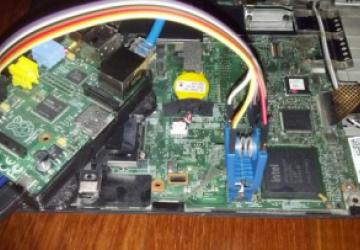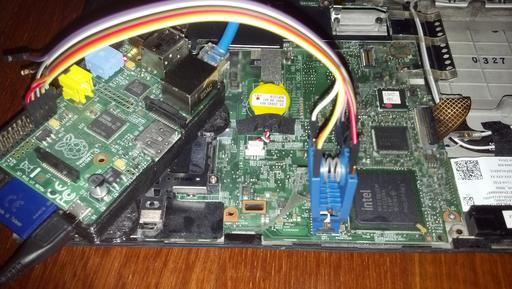Flash ROMs with a Raspberry Pi

I previously wrote a series of articles about my experience flashing a ThinkPad X60 laptop with Libreboot. After that, the Libreboot project expanded its hardware support to include the ThinkPad X200 series, so I decided to upgrade. The main challenge with switching over to the X200 was that unlike the X60, you can't perform the initial Libreboot flash with software. Instead, you actually need to disassemble the laptop to expose the BIOS chip, clip a special clip called a Pomona clip to it that's wired to some device that can flash chips, cross your fingers and flash.
I'm not generally a hardware hacker, so I didn't have any of the special-purpose hardware-flashing tools that you typically would use to do this right. I did, however, have a Raspberry Pi (well, many Raspberry Pis if I'm being honest), and it turns out that both it and the Beaglebone Black are platforms that have been used with flashrom successfully. So in this article, I describe the steps I performed to turn a regular Raspberry Pi running Raspbian into a BIOS-flashing machine.
The Hardware
To hardware-flash a BIOS chip, you need two main pieces of hardware: a Raspberry Pi and the appropriate Pomona clip for your chip. The Pomona clip actually clips over the top of your chip and has little teeth that make connections with each of the chip's pins. You then can wire up the other end of the clip to your hardware-flashing device, and it allows you to reprogram the chip without having to remove it. In my case, my BIOS chip had 16 pins (although some X200s use 8-pin BIOS chips), so I ordered a 16-pin Pomona clip on-line at almost the same price as a Raspberry Pi!
There is actually a really good guide on-line for flashing a number of different ThinkPads using a Raspberry Pi and the NOOBS distribution; see Resources if you want more details. Unfortunately, that guide didn't exist when I first wanted to do this, so instead I had to piece together what to do (specifically which GPIO pins to connect to which pins on the clip) by combining a general-purpose article on using flashrom on a Raspberry Pi with an article on flashing an X200 with a Beaglebone Black. So although the guide I link to at the end of this article goes into more depth and looks correct, I can't directly vouch for it since I haven't followed its steps. The steps I list here are what worked for me.
Pomona Clip Pinouts
The guide I link to in the Resources section has a great graphic that goes into detail about the various pinouts you may need to use for various chips. Not all pins on the clip actually need to be connected for the X200. In my case, the simplified form is shown in Table 1 for my 16-pin Pomona clip.
| SPI Pin Name | 3.3V | CS# | S0/SIO1 | GND | S1/SIO0 | SCLK |
| Pomona Clip Pin # | 2 | 7 | 8 | 10 | 15 | 16 |
| Raspberry Pi GPIO Pin # | 1 (17*) | 24 | 21 | 25 | 19 | 23 |
So when I wired things up, I connected pin 2 of the Pomona clip to GPIO pin 17, but in other guides, they use GPIO pin 1 for 3.3V. I list both because pin 17 worked for me (and I imagine any 3.3V power source might work), but in case you want an alternative pin, there it is.
Build Flashrom
There are two main ways to build flashrom. If you intend to build and flash a Libreboot image from source, you can use the version of flashrom that comes with the Libreboot source. You also can just build flashrom directly from its git repository. Either way, you first will need to pull down all the build dependencies:
$ sudo apt-get install build-essential pciutils
↪usbutils libpci-dev libusb-dev libftdi1
↪libftdi-dev zlib1g-dev subversion
If you want to build flashrom directly from its source, do this:
$ svn co svn://flashrom.org/flashrom/trunk flashrom
$ cd flashrom
$ make
Otherwise, if you want to build from the flashrom source included with Libreboot, do this:
$ git clone https://libreboot.org/libreboot.git
$ cd libreboot
$ ./download flashrom
$ ./build module flashrom
In either circumstance, at the end of the process, you should have a flashrom binary compiled for the Raspberry Pi ready to use.
Enable SPI
The next step is to load two SPI modules so you can use the GPIO pins to
flash. In my case, the Raspbian image I used did not default to enabling
that device at boot, so I had to edit /boot/config.txt as root and make
sure that the file contained dtparam=spi=on and then reboot.
Once I rebooted, I then could load the two spi modules:
$ sudo modprobe spi_bcm2708
$ sudo modprobe spidev
Now that the modules loaded successfully, I was ready to power down the Raspberry Pi and wire everything up.
Wire Everything Up
To wire everything up, I opened up my X200 (unplugged and with the battery removed, of course), found the BIOS chip (it is right under the front wrist rest) and attached the clip. If you attach the clip while the Raspberry Pi is still on, note that it will reboot. It's better to make all of the connections while everything is turned off. Once I was done, it looked like what you see in Figure 1.

Figure 1. Laptop Surgery
Then I booted the Raspberry Pi, loaded the two SPI modules and was able to use flashrom to read off a copy of my existing BIOS:
sudo ./flashrom -p linux_spi:dev=/dev/spidev0.0
↪-r factory1.rom
Now, the thing about using these clips to flash hardware is that sometimes the connections aren't perfect, and I've found that in some instances, I had to perform a flash many times before it succeeded. In the above case, I'd recommend that once it succeeds, you perform it a few more times and save a couple different copies of your existing BIOS (at least three), and then use a tool like sha256sum to compare them all. You may find that one or more of your copies don't match the rest. Once you get a few consistent copies that agree, you can be assured that you got a good copy.
After you have a good backup copy of your existing BIOS, you can attempt a flash. It turns out that quite a bit has changed with the Libreboot-flashing process since the last time I wrote about it, so in a future column, I will revisit the topic with the more up-to-date method to flash Libreboot.
Resources
Hardware Flashing with Raspberry Pi: https://github.com/bibanon/Coreboot-ThinkPads/wiki/Hardware-Flashing-with-Raspberry-Pi










